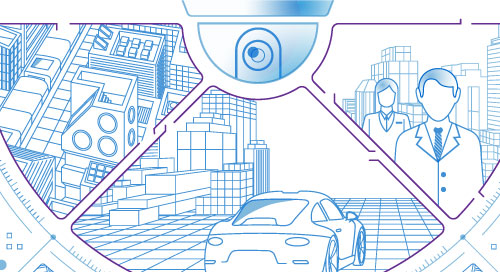Security Integrators: Turn Unused Video Into Business Value

When it comes to physical security, cameras have been a core technology for decades. But recent innovations have expanded their role beyond protection. What’s changed? AI and computer vision.
“Analytics have been around in video surveillance for a long time, but it’s advanced exponentially in the last three years with new products that include artificial intelligence and machine learning,” says Christine Lanning, president of Integrated Security Technologies, a Hawaii-based security systems integrator. “We’re able to discern new information from that video data that is smarter and more beneficial to the business.”
AI Improves Safety and Security Operations—and More
About 99 percent of data stored from video surveillance systems is never used, says Lanning, but SIs can help their customers maximize their investment in the equipment by leveraging the data to improve operations as well as customer service and satisfaction. Integrated Security Technologies, for example, adapts its systems to offer business intelligence in addition to providing traditional security services.
“Banks, for example, will use video surveillance and machine learning in cameras to determine how long people are waiting in line,” says Lanning. “The information helps them determine whether or not they need more people on the front line to service those customers. They can monitor lobby customer densities, average queue-line wait times, average customer service times, and comparative staffing levels.”
Data points can be measured against customer satisfaction scores, and the insights can be used to help optimize operations and boost the bottom line.
“Staffing efficiency can increase revenue, and minimizing service deficiencies can increase customer retention, which also adds revenue,” says Lanning. “You’ve got to balance both ends of that spectrum, and we’re giving businesses the information to do that today.”
Can security cameras do more? @PSASecurity shows how integrators can add value. via @insightdottech
AI-enabled cameras can also help the healthcare industry measure and monitor the patient lifecycle of care, which can impact post-visit satisfaction scores. Called Hospital Consumer Assessment of Healthcare Providers and Systems (HCAHPS), these reviews are publicly available and can affect hospital revenue. By leveraging the tools that are already in place for patient security, healthcare facilities can improve their operations and potentially their score.
“Nurse call systems are a major source of patient care information,” says Lanning. “The technology ‘behind the bed’ tracks the volume of patient calls, the type of call, the time to respond, and it prompts the attendant for a log entry to explain the request and service provided upon response.”
Nurse call system information is also critical to the timely turnover of beds in a hospital, Lanning adds.
“Every hour that a bed goes unoccupied due to status miscommunication or inefficient cleaning notifications and procedures, like at the end of a shift, increases the per-hour cost associated with the turnover of those beds,” she says.
By offering business intelligence capabilities, SIs can provide more value to their customers, helping to increase their return on investment. A recent example is thermal imaging systems being installed in airports to scan travelers and identify those who have a fever.
“Adding AI to a system that increases business intelligence obviously adds cost,” says Lanning. “The justification for the spend, e.g., reopening or increasing safe traveler programs, if it helps tourism and gets the economy going again, that can be a smart investment.”
Depth of Knowledge Provides Expertise
Another way SIs can differentiate themselves is by providing depth of knowledge, which can be especially important to some industries. Integrators that want to focus on a specific vertical can get expert help by partnering with a consortium like The PSA Network, the world’s largest SI consortium. Its members, such as Integrated Security Technologies, offer value through niche specializations.
“We sell the most exciting, secure systems for DOD, and we can provide that to our commercial customers, as well,” says Lanning. “Utilities, healthcare facilities, financial institutions—those critical Infrastructure sectors have regulatory requirements for security, and they’re very interested in who is installing their security. Our personnel undergo full background checks. Everyone’s trained on the safeguarding of confidential security information, so PII, HIPAA, or PCI data is continuously protected.”
“Our staff certifications and training and our operating programs truly differentiate us from companies that don’t invest in continuous improvement,” Lanning continues. “It’s easy to identify those who really don’t care. Their deliverable is just about low price, and we’ve all seen examples where that practice shows up in poor deliverables.”
Power in Partnerships
Innovative systems provide new capabilities that can impress an SI’s customers, but they’re also complex and require a variety of components. SIs that work with PSA also get support for creating the infrastructure. In addition to providing access to the latest technology and tools, PSA works with vendor partners to offer SIs proof of concept, and quick installation and scale so their end users can leverage all of the opportunities that cameras can offer.
And Integrated Security Technologies’ involvement with PSA provides more value by creating ways to partner with other PSA consortium members to compete for multi-state projects.
“PSA’s National Deployment Program (NDP) provides us with the ability to bid on contracts with PSA partner integrators,” says Lanning. “Last year, we bid for a multi-state contract for the DOD, and we were able to subcontract work to PSA partners in 10 states. Our relationship with those other PSA company owners ensures that those remote installations will be handled with the same level of care that we would give to our Hawaii clients. That level of confidence is unique to the PSA member/owner community.”
“Security integration is a technology business, and we’re better off as an industry if we can align ourselves with IT standards,” explains Lanning. “It’s just going to help propel us all forward. Our systems and our companies are part of the IT ecosystem, and our alignment within that ecosystem is extremely important to the future of our industry.”